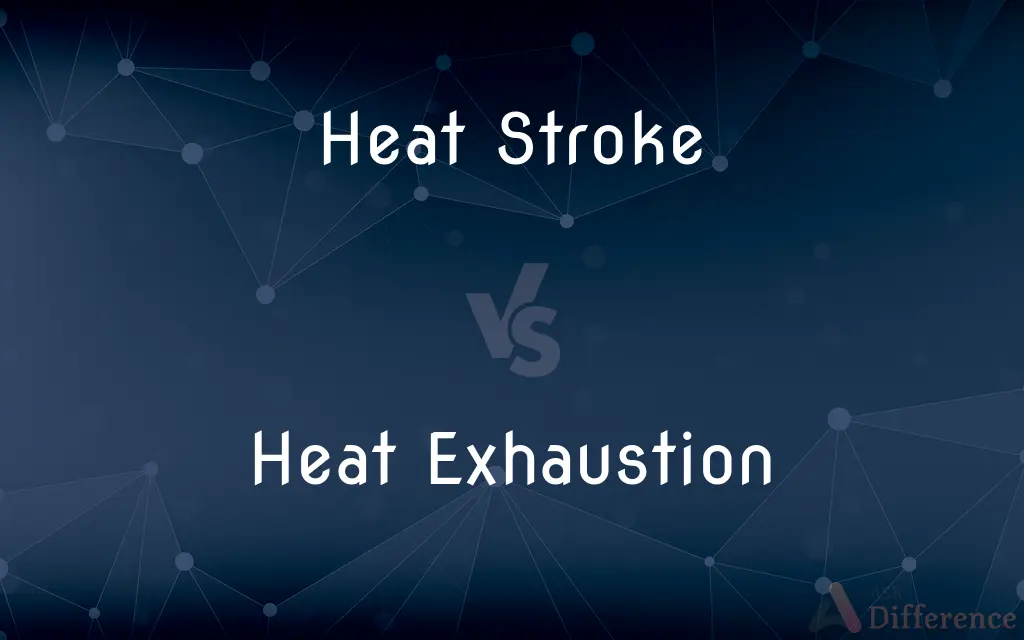Heat Stroke vs. Heat Exhaustion — What's the Difference?
Edited by Tayyaba Rehman — By Fiza Rafique — Published on March 3, 2024
Heat stroke is a severe, life-threatening condition marked by body overheating, with body temperatures above 104°F (40°C). Heat exhaustion is milder form of heat-related illness that can precede heat stroke, having symptoms like sweating and rapid pulse.

Difference Between Heat Stroke and Heat Exhaustion
Table of Contents
ADVERTISEMENT
Key Differences
Heat stroke is an emergency condition characterized by the body's failure to regulate its temperature, leading to a rapid rise in body temperature, confusion, and possibly loss of consciousness. It requires immediate medical attention. Heat exhaustion, on the other hand, is less severe, with symptoms including heavy sweating, weakness, and dizziness, often resulting from dehydration or prolonged exposure to high temperatures.
Heat stroke can manifest suddenly without warning, whereas heat exhaustion often precedes it, serving as a warning sign. Individuals experiencing heat exhaustion may exhibit cool, moist skin with goosebumps despite the heat, a stark contrast to the dry, hot skin seen in heat stroke cases.
Treatment approaches differ significantly; heat exhaustion can often be managed through rest, hydration, and cooling measures, whereas heat stroke necessitates urgent medical interventions such as intravenous fluids and cooling strategies to prevent organ damage.
Prevention is key for both conditions. Staying hydrated, avoiding peak sun hours, and wearing lightweight clothing can help prevent heat exhaustion and, by extension, heat stroke. Recognizing the symptoms early on can be crucial in preventing the progression from heat exhaustion to the more severe heat stroke.
Comparison Chart
Core Temperature
Above 104°F (40°C)
Below 104°F (40°C)
ADVERTISEMENT
Skin Condition
Dry, hot, and may be red
Cool, moist, and may appear pale
Onset
Rapid and severe
Gradual and less severe
Symptoms
Confusion, seizures, loss of consciousness
Heavy sweating, weakness, dizziness
Treatment
Immediate medical intervention
Rest, hydration, cooling measures
Urgency
Life-threatening; requires emergency care
Less urgent; can often be treated on-site
Compare with Definitions
Heat Stroke
A severe heat-related illness characterized by a body temperature above 104°F.
After jogging in the midday sun, John suffered a heat stroke and required immediate hospitalization.
Heat Exhaustion
Prevention involves staying hydrated and cool during hot weather.
She prevented heat exhaustion by wearing a hat and drinking fluids regularly.
Heat Stroke
An emergency condition requiring urgent medical attention to prevent organ damage.
Heat stroke victims often exhibit confusion and may lose consciousness.
Heat Exhaustion
Symptoms include dizziness, muscle cramps, and nausea.
Feeling dizzy and nauseous in the heat, he recognized these as symptoms of heat exhaustion.
Heat Stroke
Marked by the absence of sweating, despite the heat.
Despite the scorching sun, she stopped sweating—an alarming sign of heat stroke.
Heat Exhaustion
A heat-related illness characterized by heavy sweating and a rapid pulse.
After hiking in the heat without adequate water, she felt the onset of heat exhaustion.
Heat Stroke
Can result in severe complications or death if not treated promptly.
Untreated heat stroke can lead to multiple organ failure.
Heat Exhaustion
A condition that can progress to heat stroke if not addressed.
Ignoring signs of heat exhaustion can lead to a more dangerous heat stroke.
Heat Stroke
It is preventable with proper hydration and avoiding excessive heat.
Wearing light clothing and drinking plenty of water can prevent heat stroke.
Heat Exhaustion
Treatable with hydration, rest, and cooling.
Moving to a cooler place and drinking water can quickly alleviate heat exhaustion symptoms.
Common Curiosities
What are the first signs of heat exhaustion?
The first signs include heavy sweating, weakness, dizziness, muscle cramps, and nausea.
Is it possible to have heat stroke without previous heat exhaustion?
Yes, heat stroke can occur suddenly without warning or the preceding signs of heat exhaustion, especially in extreme heat conditions or with strenuous activity.
What increases the risk of heat-related illnesses?
Factors include high temperatures and humidity, dehydration, direct sun exposure, lack of acclimatization, and certain medications or health conditions.
How do you treat someone with heat stroke?
Call emergency services immediately. Move the person to a cooler place and try to cool them down with wet cloths or a bath, but do not give them fluids.
Can children and pets get heat stroke?
Yes, both children and pets are at high risk for heat stroke and require protection during hot weather.
Can drinking alcohol increase the risk of heat stroke or heat exhaustion?
Yes, alcohol can dehydrate the body and impair its ability to regulate temperature, increasing the risk of heat-related illnesses.
Can heat exhaustion turn into heat stroke?
Yes, if untreated, heat exhaustion can escalate into heat stroke, a more severe and potentially life-threatening condition.
What should you do if you suspect heat exhaustion?
Move to a cooler place, rest, and hydrate. If symptoms worsen or don't improve within an hour, seek medical attention.
What is the main difference between heat stroke and heat exhaustion?
Heat stroke is a severe condition with a body temperature above 104°F and can be life-threatening, requiring emergency medical care. Heat exhaustion is milder and characterized by symptoms like heavy sweating and dizziness.
How long does it take to recover from heat exhaustion?
Recovery can take 24-48 hours with proper treatment, including rest and hydration.
How can heat stroke be prevented?
Preventive measures include staying hydrated, avoiding peak heat hours, wearing lightweight clothing, and acclimatizing to hot environments gradually.
Are athletes more susceptible to heat-related illnesses?
Yes, athletes are at higher risk due to intense physical exertion in hot conditions, underscoring the importance of acclimatization and hydration.
Does humidity affect the risk of heat stroke and heat exhaustion?
Yes, high humidity can increase the risk by preventing sweat from evaporating, which is the body's way of cooling down.
What is the most important step to take if someone is showing symptoms of heat stroke?
The most crucial step is to call emergency services immediately and begin cooling the person down while waiting for medical help to arrive.
What are the long-term effects of heat stroke?
Potential long-term effects include kidney and muscle damage, and in severe cases, brain damage or death.
Share Your Discovery

Previous Comparison
Jet vs. Plane
Next Comparison
NPT vs. MPTAuthor Spotlight
Written by
Fiza RafiqueFiza Rafique is a skilled content writer at AskDifference.com, where she meticulously refines and enhances written pieces. Drawing from her vast editorial expertise, Fiza ensures clarity, accuracy, and precision in every article. Passionate about language, she continually seeks to elevate the quality of content for readers worldwide.
Edited by
Tayyaba RehmanTayyaba Rehman is a distinguished writer, currently serving as a primary contributor to askdifference.com. As a researcher in semantics and etymology, Tayyaba's passion for the complexity of languages and their distinctions has found a perfect home on the platform. Tayyaba delves into the intricacies of language, distinguishing between commonly confused words and phrases, thereby providing clarity for readers worldwide.
















































